TWO SECRET VILLAGES IN PARIS
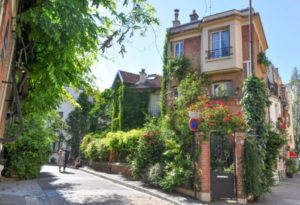
If you’ve been to Paris a few times, no doubt you’ve taken in the big, headline monuments and sites such as the Eiffel Tower, Arc de Triomphe, Louvre, walked along the Champs Elysees and shopped ’til you dropped in Galeries Lafayette. These iconic places are internationally famous for a very good reason, but for your next visit, I’d like to suggest some hidden little pockets to explore that most likely you’ve never heard of. There are a number of charming little havens of tranquility that were once small communities in their own right, but have since been absorbed into the fabric of one of the most densely populated cities on the planet. Such little gems are what really make Paris the unique, much-loved city that it is today.

Every corner of Paris has its charms, but one of its lesser-known neighbourhoods that’s beloved by locals but overlooked by tourists, is the Butte aux Cailles (“quail hill”) district. It has retained its village-like ambience in the city’s otherwise ultra-contemporary 13th arr., not far from Place d’Italie. “La Butte” is the French term for hill, which is a little hint that the area is indeed not flat! Not as high as the Butte de Montmartre, la Butte aux Cailles is the second-highest spot on the Left Bank after le Mont Saint-Geneviève where the Panthéon sits.
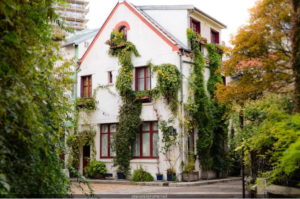
Known for its Art Nouveau and Art Deco architectural heritage, you will find narrow, cobblestone streets harbouring quirky restaurants and cafes that spill out onto the footpath, patisseries and boutiques—but no global chain stores.
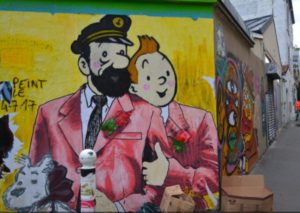
It comes as no surprise to learn that it has become a favourite spot for artists, and more recently, affluent hipsters, evident in the area’s abundant murals and street art, lofts with leafy rooftops, and gourmet food shops.
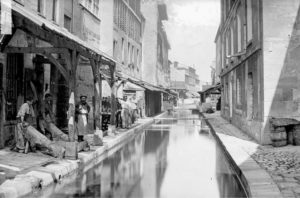
Rather than the small game bird of the same name, La Butte aux Cailles was named after a family named Cailles who had a vineyard here on the hillside in 1543 in what was then well and truly outside Paris. The area gradually grew to become a working class, fenced-in village that overlooked the (now extinct) river Bievre. The river once made this area important for the tannery trade, and limestone mining was a primary activity in the area during the 17th century, and until the 19th century 200 water mills turned on the Bievre. In 1783, the first ever hot air balloon ride in history was taken from the Butte aux Cailles by François Pilâtre de Rozier.
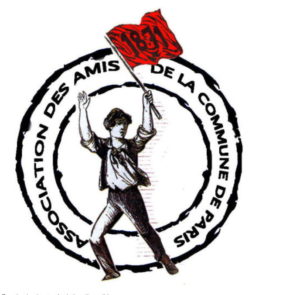
The area was annexed into Paris in 1860, and being staunchly working class, was the centre of an important battle in the civil insurrection known as the Paris Commune of 1871. You can see a memorial to the Commune at Place de la Commune de Paris in the centre of the district. The Butte is also home to L’Association des Amies et Amis de la Commune de Paris 1871. Their small shop sells a selection of books, posters and other items relating to the Commune.
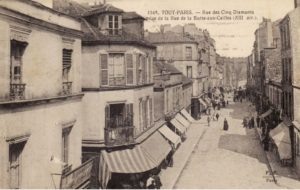
To explore this distinctive quartier, be sure to have a very detailed Paris street map, or activate the GPS function on your smartphone. Take the metro to Corvisart or Place d’Italie, and walk up rue des Cinq Diamants until you hit the heart of the neighbourhood at rue de la Butte aux Cailles. The main street of the neighbourhood is rue de Cinq Diamants, which intersects rue de la Butte aux Cailles. Make a stop at one of the quaint cafes, browse the little shops for locally made products and typical French home décor items, and there’s an indoor flea market, Antiquitiés de la Butte aux Cailles, at 31 rue Vergniaud.
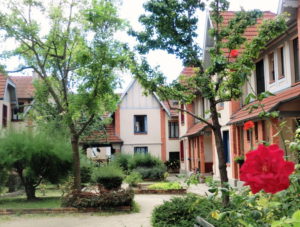
As you wander up and down the little streets you’ll see on rue Daviel small houses, some with decorative timbers and tiles, which are part of La Petite Alsace—also known as Cité Daviel—a public housing project from the early 1900s, arranged around a 500 sq.m. courtyard. A little touch of Alsace in Paris!
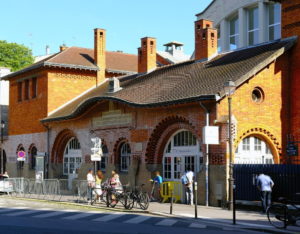
In 1866 a natural hot spring was discovered, and to take advantage of the waters, public baths were constructed in 1908 on Place Paul Verlaine. Then in 1924 a more impressive Art Nouveau-style swimming pool was built, supplied by the hot spring. This stunning public pool is still in operation today, filled by that same hot spring, so pack your bathing suit in your day bag if you fancy the idea of taking a dip.
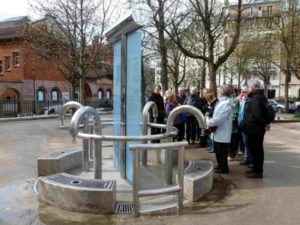
During the day, locals and other Parisians in the know arrive at Place Paul Verlaine with empty water bottles to fill from the artesian well built in 1872. The spring water comes from a depth of 580m. During the evening, the Place bustles with multiple games of pétanques underway.
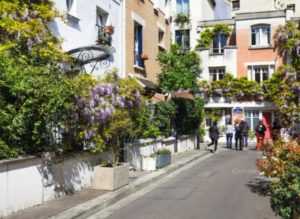
In the very middle of the Butte aux Cailles area, you will find the Cité Florale, between rues Boussingault, Brillat-Savarin and August Lançon. This is a small, charming corner where you will find little town houses with pastel-coloured façades, covered in luxuriant vines, and balconies full of flowers, and in spring, there’s lots of wisteria. The beautifully scented cobble-stone streets divide the well-named Cité Florale into different squares—in total, six streets make up the Cité Florale. A delightful place to stroll.
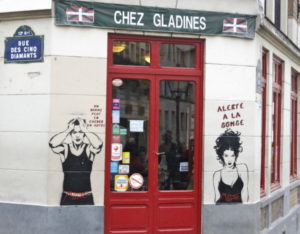
Among the winding streets worth exploring are rue des Orchidées, rue des Iris, rue des Liserons and rue des Glycines. They are all beautifully picturesque. A good spot for lunch is the very popular Chez Gladines, at 30 rue des cinq Diamants, known for their huge salads and Basque cuisine. It’s also well worthwhile taking a small detour to the absolutely delightful Parc Montsouris while you’re in the neighbourhood.

Opposite Parc Montsouris, off rue Nansouty, is Square de Montsouris. The ‘square’ is actually a 200m long cobble-stone road, on a fairly sharp bend in the road, behind an ivy-clad house.
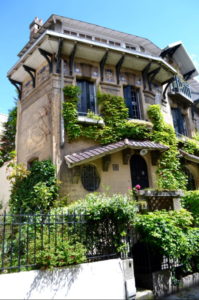
The road is packed with Art Deco and Art Nouveau architecture, the lush greenery creates an atmosphere which feels as though the road is an extension of the park itself. Built during the interwar period, the road is full of properties to admire, some with beautiful Art Nouveau mosaic friezes hiding under the eaves.
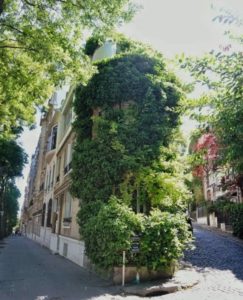
Take no notice of the sign saying ‘voie privée’—it is indeed open for non-residents to visit.
At the other end of the city is the quartier Charonne. It was a separate village surrounded by vineyards, as the location was ideal, being situated on the southern slope of Belleville hill and watered by a number of springs.
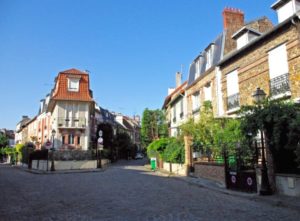
Although it became part of the city of Paris in 1860 by a decree of Napoleon III, and now belongs to the southern half of the 20th arr., it has managed to retain the charm of the old neighbourhoods with its cobbled streets and low scale houses, and little-known parks and gardens. For most of its existence, Charonne was a quiet, bucolic place, where rich Parisians had country houses and sent their children to be brought up by nannies.
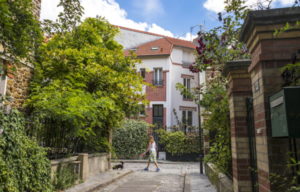
Although apartment buildings have inevitably sprung up in the surrounding area, you could almost forget you are in the capital as the old village has managed to retain its somewhat rustic appeal, and feels more like ‘La Campagne à Paris’ (the countryside in Paris). This rather rural atmosphere is particularly evident around a maze of cobblestoned streets, rues Irénée-Blanc, Georges-Perec, Paul-Strauss, and Jules-Siegfried, with pretty brick and stone houses that were once those of the quarry workers of the rue des Montiboeufs.

The historic centre of Charonne is located around the junction of rue de Bagnolet and the very attractive rue St. Blaise, with its pretty restored façades, which used to be the village high street. Close by is the delightful Square des Grès, lined by charming little houses, making it a lovely place to stroll.
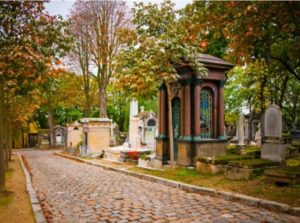
Anyone who has visited Paris’s Père Lachaise cemetery had already visited part of the Charonne quartier. The best known of the city’s cemeteries was opened in 1804, but beyond this megalopolis of the dead though, is the true village cemetery, a pocket-sized burial ground situated behind the Église de St Germain de Charonne, which is a listed Monument Historique and well worth a look.
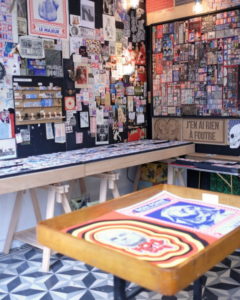
There are a couple of metro stations for the quartier Charonne, one being metro Alexandre Dumas (Line 2). Alternatively, another is take the metro to Philippe Auguste (also Line 2), walk up rue Pierre Bayle, and at the end turn right into the appropriately-named rue du Repos (rest), which runs alongside the wall of the Père Lachaise cemetery. Near the end of the street, you’ll come across a rather unusual shop, Le Tampographe Sardon. This is a workshop-cum-gallery where all kinds of rubber stamps are designed and hand-made. Children and adults alike will enjoy the caustic humour of some of the messages, the romantic illustrations, or the elegant graphics.
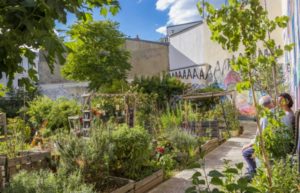
No. 2 bis Cité Aubrey is home to a delightful community garden. A haven of tranquillity tucked between the buildings, it’s a tiny green lung where local families grow tomatoes, herbs and bright sunflowers. This urban kitchen garden has one particularly unusual feature: the large-scale murals painted by street artists on the surrounding wall.
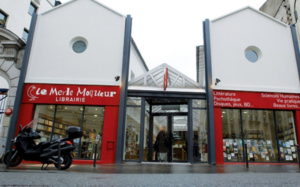
Le Merle Moqueur at 51 rue de Bagnolet, is a very good local bookshop housed in a former warehouse. It’s a general bookshop with a wide selection of titles including literature, children’s books and travel guides. Opposite the bookshop you’ll find Le Quartier Rouge, a pleasant café and restaurant, and an ideal place to relax and soak up the atmosphere of this bustling street.
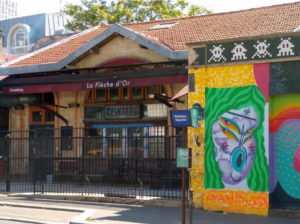
At 102 bis rue de Bagnolet is Le Fleche d’Or (Golden Arrow), you are looking at what used to be Charonne railway station. The site was named after the train that ran on this line, inaugurated in September 1926, operating a daily service from Paris to London via Calais and Dover. In the 1990s, the building was converted, and La Fleche d’Or became one of the trendiest concert venues in Paris. Its renown sprang from its reputation for spotting upcoming musical talent in the pop, folk and rock genres. The concert hall closed its doors in 2016 and the venue was repurposed late 2020 as a performance space for various cultural groups.
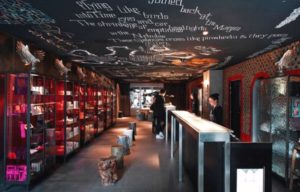
Across the road is Mama Shelter, the uber-trendy East Parisian hotel designed by Philippe Starck. It has a roof terrace with a magnificent view over the city. Next door is the Marguerite Duras multimedia library, one of the most innovative in Paris. As well as being a municipal library, it also features an exhibition area, auditorium, and on the top floor, a multimedia collection dedicated to Eastern Paris, where you can learn more about the area.
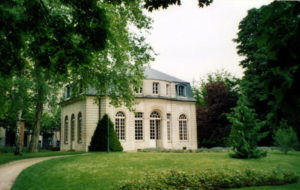
You will soon reach the lovely gardens of the Hospice Debrousse at 148 rue de Bagnolet which is also the setting for the imposing Louis XIV style Pavillon de l’Ermitage. This is the only vestige of the part of the Chateau de Bagnolet, formerly the property of the Duchess of Orleans. It takes it name from the wall paintings inside that represent hermits meditating.
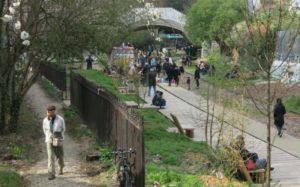
Although there are no great monuments or particular sites to see, there are some surprises, such as the old Petite Ceinture railway line which appears overhead near the busy rue des Pyrenees. A long section of the old line has recently opened as a delightful pathway where you will find locals taking a gentle stroll along the disused railway tracks.
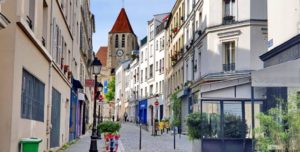
These are just some of the interesting nooks and crannies of this vast city that make an interesting change from the big, expected monuments and sites. We’ll look at some more relatively unknown but fascinating neighbourhoods of Paris in a future story.


As always, a fascinating read. Love the history.
Hi Nadine,
Yes, they’re both little gems–especially as they’re so unexpected. We were shown La Butte aux Cailles a few years ago by a good friend who lives not very far from there. Although quite familiar with the general neighbourhood, we had no idea it existed until then. Regards, Cheryl
I like the sound of that Philippe Starck hotel. I have copies of his chairs in my dining room. I will make sure I visit next time …
Hi Lois,
He’s such an interesting designer, with such a breadth of projects. I found it such an interesting location for such a high style hotel by someone with Starck’s reputation. Fascinating!
Cheers, Cheryl